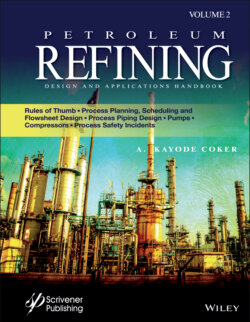Читать книгу Petroleum Refining Design and Applications Handbook - A. Kayode Coker - Страница 24
DRYING OF SOLIDS
Оглавление1 1. Drying times range from a few seconds in spray dryers to 1 h or less in rotary dryers and up to several hours or even several days in tunnel shelf or belt dryers.
2 2. Continuous tray and belt dryers for granular material of natural size or pelleted to 3–15 mm have drying in the range of 10–200 min.
3 3. Rotary cylindrical dryers operate with superficial air velocities of 1.52–3.05 m/s (5–10 ft/s), sometimes up to 10.67 m/s (35 ft/s) when the material is coarse. Residence times are 5–90 min. Holdup of solid is 7–8%. An 85% free cross section is taken for design purposes. In countercurrent flow, the exit gas is 10–20°C above the solid; in parallel flow, the temperature of the exit solid is 100°C. Rotation speeds of about 4 rpm are used, but the product of rpm and diameter in feet is typically between 15 and 25.
4 4. Drum dryers for pastes and slurries operate with contact times of 3–12 s, and produce flakes 1–3 mm thick with evaporation rates of 15–30 kg/m2-h. Diameters are in the range of 1.5–5.0 ft; and rotation rate is 2–10 rpm. The greatest evaporative capacity is of the order of 1360.7 kg/h (3000 lb/h) in commercial units.
5 5. Pneumatic conveying dryers normally take particles 1–3 mm diameter but up to 10 mm when the moisture is mostly on the surface. Air velocities are 10–30 m/s. Single-pass residence times are 0.5–3.0 s, but with normal recycling the average residence time is brought up to 60 s. Units in use range from 0.2 m in diameter by 1 m long to 0.3 m in diameter by 38 m long. Air requirement is several SCFM per lb of dry product/h.
6 6. Fluidized bed dryers work best on particles of a few tenths of a mm in diameter, but particles of up to 4 mm in diameter have been processed. Gas velocities of twice the minimum fluidization velocity are a safe prescription. In continuous operation, drying times of 1–2 min are enough, but batch drying of some pharmaceutical products employs drying times of 2–3 h.
7 7. Spay dryers: Surface moisture is removed in about 5 s, and most drying is completed in less than 60 s. Parallel flow of air and stock is most common. Atomizing nozzles have openings 3–3.8 mm (0.012–0.15 in.) and operate at pressures of 21–276 bar (300–4000 psi). Atomizing spray wheels rotate at speeds of 20,000 rpm with peripheral speeds of 76.2–183 m/s (250–600 ft/s). With nozzles, the length-to-diameter ratio of the dryer is 4–5; with spray wheels, the ratio is 0.5–1.0. For the final design, the experts say, pilot tests in a unit of 2 m diameter should be made.
